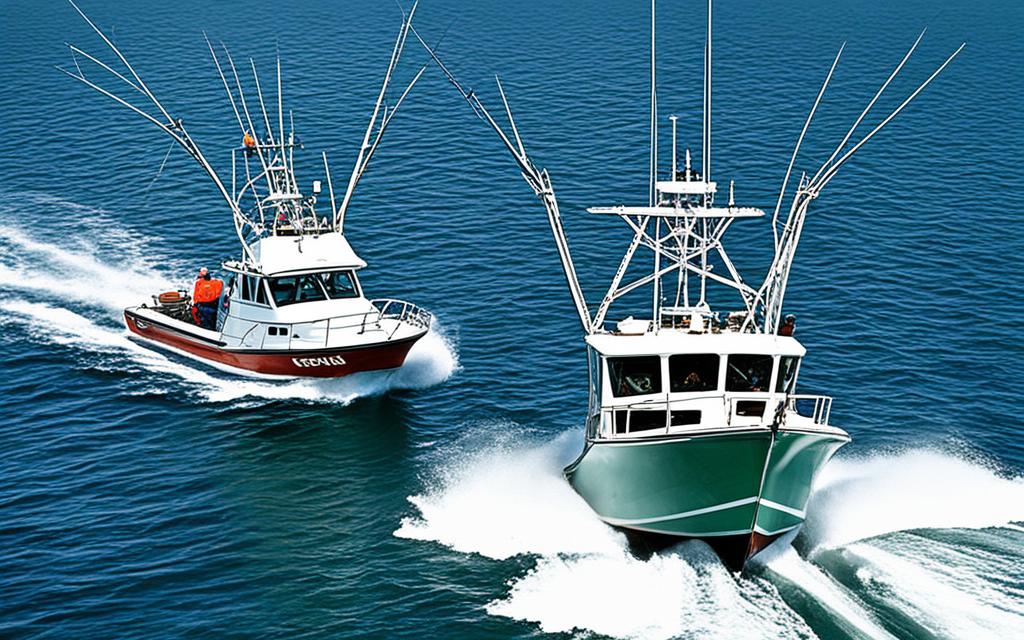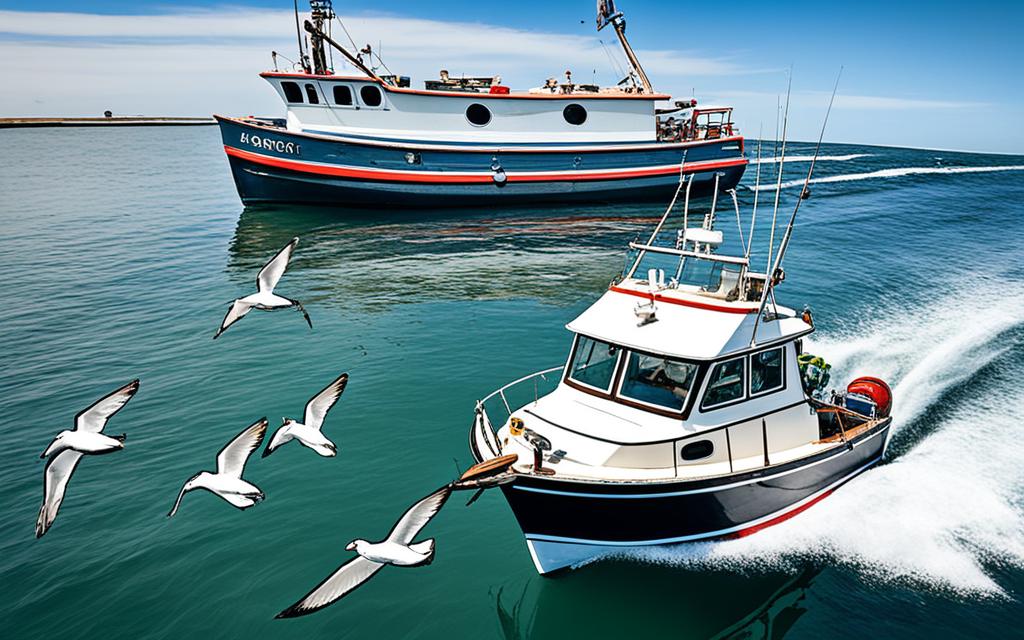When you’re out boating or fishing, knowing how to pass a fishing boat safely is key. More people are getting into sport fishing and offshore boating. This means you’ll likely run into other boats, like fishing boats, more often.

It’s important to keep a safe distance and follow the right rules when passing a fishing boat. This helps prevent accidents and keeps the water safe for everyone. Fishing boats often have lines and ropes in the water that can be dangerous to other boats. By knowing the risks and following the right steps, you can have fun on the water without the risk of hitting or getting tangled with another boat.
Key Takeaways
- Always maintain a safe distance of at least 50 feet when passing a fishing boat.
- Pass on the starboard side (right-hand side) of the fishing boat.
- Maintain a consistent speed to avoid startling the anglers.
- Be aware of fishing lines and ropes extending from the boat.
- Communicate your intentions by honking the horn and waiting for a reply signal.
Importance of Boating Safety
Boating safety is key to having fun on the water. With over 83 million Americans boating yearly, safety is crucial. It helps prevent accidents and collisions.
Increased Number of Boaters on the Water
More people are boating now, which brings new dangers. The COVID-19 pandemic led to a surge in new boat buyers. This means more boats on the water during peak times like the Fourth of July weekend.
It’s vital to know the risks and be prepared. Completing a boating safety course can save lives. In Florida, 85% of boating deaths were from those who didn’t take a course.
Learning about boat handling, weather, navigation, and engine care can lower accident risks. This makes boating safer for everyone.
| State | Boating Safety Education Requirements |
|---|---|
| Florida | Required for operators born on or after January 1, 1988 |
| California | Required for operators of motorized vessels |
| New York | Required for all operators born on or after May 1, 1996 |
| Texas | Required for operators born on or after September 1, 1993 |
Unique Dangers Posed by Fishing Boats
Fishing boats bring special dangers that need extra care. Anglers often use lines and ropes in the water, which can get tangled with other boats. This can cause collisions and accidents.
Smaller fishing boats, like semi-v-hull boats and canoes, are more likely to tip over. Overloading these boats and not wearing life jackets increases risks. Fishing alone can also make it harder to get help in an emergency.
Knowing the dangers of fishing boats helps boaters stay safe. Keeping a safe distance, watching for fishing gear, and wearing life jackets can prevent accidents. This makes boating more enjoyable for everyone.
Understanding the Risks of Passing Fishing Boats
When you’re out on the water, it’s key to know the dangers of passing fishing boats. These boats often have gear like fishing lines, ropes, and nets spread out. If you cross these without care, you could cause accidents, damage boats, or get hurt.
Presence of Lines and Ropes in the Water
Fishing boats, big or small, have lines, ropes, and nets in the water. They use:
- Trolling lines for species like salmon or tuna
- Long-lines with multiple baited hooks
- Gill nets or purse seine nets for commercial fishing operations
- Crab or lobster pots marked by buoys and connected by ropes
When you pass a fishing boat, keep a safe distance from these lines and nets. Getting tangled can damage your boat or the fishing gear. This can lead to expensive repairs for everyone.
Potential for Collisions and Accidents
Passing too close to a fishing boat can also lead to collisions. This happens for a few reasons:
| Factor | Description |
|---|---|
| Limited maneuverability | Fishing boats with gear out may not move quickly to avoid a collision. |
| Distracted crew | Fishermen might be busy with their work and miss seeing approaching boats. |
| Wake and wash | The wake from a passing boat can make a fishing vessel rock or roll. This can cause people to fall or damage equipment. |
| Reduced visibility | In low light or rough seas, it’s harder to see a fishing boat and its gear. |
Both the passing boat and the fishing boat must work together to stay safe and avoid accidents. Knowing the risks and following the right steps helps make the water safer for everyone.
Rules and Courtesy When Passing a Fishing Boat
As a boat owner, knowing the maritime rules and boating etiquette is key when near fishing boats. These rules help keep everyone safe on the water.

Not Allowed to Pass Over Lines Without Clearance
Remember, you can’t pass over fishing boat lines without permission. Fishing boats use lines and ropes far out into the water. These can be dangerous to other boats. Always wait for the fishing boat to give you the okay before crossing their lines.
Always communicate with the fishing boat before attempting to pass over their lines. This simple act of courtesy can prevent accidents and ensure everyone’s safety on the water.
Boat Owner’s Responsibility to Maintain Safe Practices
As a boat owner, you must always keep the water safe. This means following navigation rules, knowing the right-of-way, and talking to other boats. These actions help make boating safer for everyone.
Here are some tips when near a fishing boat:
- Slow down to reduce your wake, which can be a hazard for fishing boats
- Try to pass on the right side of the fishing boat if you can
- If you need to pass on the left side, talk to the fishing boat first
- Use sound signals to show your plans and wait for the fishing boat’s go-ahead
| Vessel Type | Right-of-Way Hierarchy |
|---|---|
| Fishing Vessels (with gear out) | Highest priority |
| Sailing Vessels (under sail power) | Second highest priority |
| Power-driven Vessels | Lowest priority |
Following these maritime rules and being polite helps make boating safe and fun for all. A bit of courtesy and talking can prevent accidents and make navigating easier.
Proper Procedure for Passing a Fishing Boat
When you meet a fishing boat on the water, it’s key to pass it safely. The US Coast Guard suggests passing on the port side (left) when you can. This makes it easier to see each other and talk.
Passing on the Port Side (Left-Hand Side)
Start a pass on the port side by sounding your horn once. The fishing boat should answer with one horn blast to say it’s okay to pass. If they don’t answer or sound two blasts, wait for their signal to pass.
Keep your speed slow while passing to reduce your wake. This helps keep a safe distance from the fishing boat.
Steering to the Starboard Side (Right-Hand Side)
Sometimes, like when fishing lines are on the port side, you might need to pass on the starboard side (right). Sound your horn twice to signal you’re passing from the right. The fishing boat should also sound two blasts to confirm it’s safe.
If they don’t respond or sound one blast, wait for their signal before passing. Always make sure it’s clear to pass before you do.
Communicating with the Other Boat
Good communication is key when passing a fishing boat. Use horns, hand signals, flags, or talk to show your intentions. Always wait for the fishing boat to confirm it’s safe to pass.
Keep your speed slow to reduce your wake and make any needed changes in direction. Clear communication and following these steps help boaters pass fishing boats safely, making the water safer for everyone.
FAQ
What should I do if I encounter fishing or hunting boats while paddling?
If you see fishing or hunting boats, be polite and keep a safe distance. Don’t cross their fishing lines. These lines can be set far from the boat or trail behind it.
Why is maintaining safety on the water crucial when passing fishing boats?
Safety is key when passing fishing boats because there’s a right way to do it safely. With more boaters out there, the risk of hitting fishing boats goes up. These boats often have lines and ropes far out in the water.
What are the risks associated with passing fishing boats?
Fishing boats have ropes, lines, and nets that stretch far into the water. If you cross these, you could cause accidents or damage to boats. It’s important to be careful.
What are the responsibilities of the passing boat and fishing boat in avoiding accidents?
Both boats must work together to avoid accidents. It’s a rule not to cross fishing lines without permission. As a boat owner, you must follow safe practices on the water.
What is the proper procedure for passing a fishing boat on the starboard side?
To pass a fishing boat on the right, move so you both pass on the left. Honk once to signal, then wait for a single honk back. Keep your wake to a minimum as a courtesy.
How do I pass a fishing boat on the port side?
For passing on the left, sound your horn twice and wait for a double-blast reply. Always keep your wake small to keep everyone safe.